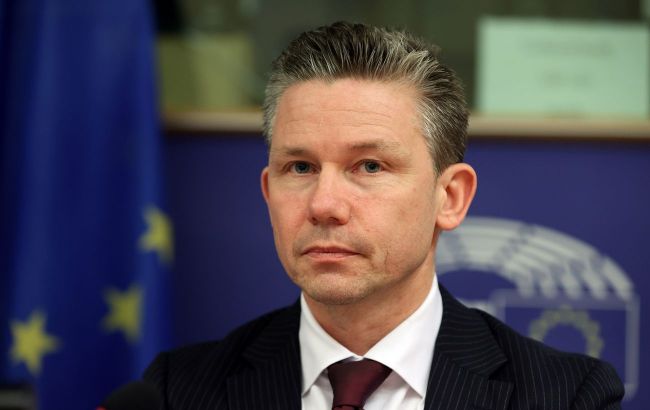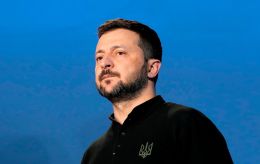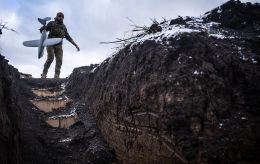'Russian provocations against NATO have three predominant objectives,' Pål Jonson, Swedish DM
 Pål Jonson, Defense Minister of Sweden (Photo: Getty Images)
Pål Jonson, Defense Minister of Sweden (Photo: Getty Images)
In a brief interview with Swedish Defense Minister, Pål Jonson, discusses the latest Russian attacks and provocations against European NATO member states, the downing of Russian planes and drones by allies, the delivery of Gripen aircraft to Ukraine, and joint defense production with Ukraine
RBC-Ukraine spoke with Jonson on the sidelines of NATO headquarters, where yesterday's meeting of the Ukraine Defense Contact Group on aid to Ukraine and a gathering of Alliance defense ministers took place.
The main practical outcome is a significant increase in the number of countries participating in the PURL initiative, meaning they are ready to finance the purchase of US weapons for Ukraine's needs.
Sweden is one of the countries that joined PURL early on, and more broadly, this country has actively supported Ukraine from the very first days of the full-scale invasion.
In addition, Stockholm takes the potential Russian threat very seriously. Sweden clearly appears to be one of the potential targets for aggressors - provocations from Russia have occurred here repeatedly in recent times.
– In your opinion, what is Russia's main goal in all the recent provocations against European NATO members? Is it testing NATO member states' technical capabilities or the political will and reaction of the leadership, or both?
– Russia has three predominant objectives. One is to test the Alliance's cohesion and resolve politically.
The second is to test the Alliance's readiness on a military level.
And third, to divert attention from supporting Ukraine.
Russia wants to scare us from supporting Ukraine, but they will fail. Therefore, we strongly welcome that now we have a new Eastern Sentry mission to take not just political words, but also to take military measures to strengthen our deterrence capabilities.
I was glad during the meeting that we went from six countries that are doing the PURL initiative to 20 today as well. So, that's also a sign of increasing support for Ukraine from today's meetings.
– In your opinion, has Russia failed in achieving all the goals you mentioned, as of now?
– For sure, the political cohesion has been very strong, as has been the solidarity with those countries that have been affected, with Poland, with Romania, with Estonia. And that has been in combination and conjunction with taking new military measures to strengthen our deterrence through Eastern Sentry.
And I think that the military aircraft that's been in operation has acted commendably. I welcome the fact that the F-35s from the Netherlands shot down the Russian drones. The Italian F-35s pushed out the MiG-31s, and then the Swedish jets came and followed them as well. So, I think things have been working very well on a military level.
But we need to do more inside NATO. We need to ensure that SACEUR has the right mandate to move assets and capabilities within the Alliance. So, that's effective for deterrence.
We also have to make sure that there are strong rules of engagement across all Allied territories. And all the Allies, of course, are willing and able to defend every inch of the Allied territory.
– Several weeks ago, you said that the NATO members should 'change their peaceful mindset'. Have you noticed this at today's meetings?
– Definitely, the trajectory is moving in the right direction. I think that this has been another wake-up call with the Russian incursions into the Allied territories, that Russia is willing to take political and military risk, and that it's been stepping up its hybrid operations. And therefore, we have to come through that, and we have to push back.
– When responding to different Russian provocations, in your opinion, should the decision to engage, for example, to shoot down an aircraft, be made collectively at the NATO level or should each individual country decide on its own?
– I think we have a very clear mandate in Sweden, where if you do an incursion into Swedish airspace with a foreign military aircraft, then the first measure would be to tell them to leave our territory. But if you pose a military threat, you will eventually be shot down. You cannot make decisions about a war by committee, but that's actually for the pilot or for the commander of the surface vessel to make that call.
– But in different countries, there are different rules.
– We learned quite a lot from having submarine incursions in the early 1980s. Then we adopted a new law in 1983. It has to be the force commander or the pilot who makes the decision.
Otherwise, it's not going to work because things are so fluid and changing all the time. If you have to receive approval, then it takes away the military efficiency.
– Technologies that Russia uses against Ukraine and European NATO countries, such as drones, are cheap yet effective. How will the West respond, in particular by scaling up drone production together with Ukraine, but on NATO territory?
– We have a great European defense industry, but it's a little bit too slow and it's a little bit too expensive. Therefore, we have to be inspired by what's happening in Ukraine, which has scaled up production very significantly, from 100 major companies to 800.
So you have a very dynamic and effective defense industry market, which we need to learn from. One of the things, of course, is that we opened up for co-production.
I've been to Ukraine with industry delegations. Last time I was in Kyiv, I signed an agreement with Minister Shmyhal, also opening up production in Sweden by Ukrainian companies, so they can do it in the protective measures inside Sweden. And we can also learn from your production capacity.
 Pål Jonson at the NATO Defense Ministers meeting (photo: Getty Images)
Pål Jonson at the NATO Defense Ministers meeting (photo: Getty Images)
– I can't help asking you about the Gripens. I heard that you said that the consultations on this are ongoing. But when can these consultations be successfully concluded?
– We do have a very good dialogue with Ukraine about this. And to my mind, the most efficient thing would be if we could build a common air force capability and air defense capability around the Gripen Echo, which is the newest version, which has very good electronic warfare, which is very efficient, etc. And I know there is an interest on the Ukrainian side.
So if we can do this together, I think it would be good for Ukraine. It would be good for Sweden. And it would be good for Europe. But I don't have a date.
– Do you discuss the idea of lifting the embargo on financing Ukrainian armed forces directly by Western funds?
– The very first support package from Sweden was 100 million dollars, directly to the National Bank of Ukraine, and for your armed forces.
But we prefer to give you weapons and pay your industry instead. But it would be possible.
– At today's ministerial, have you discussed strategic issues beyond the immediate and future aid to Ukraine? I mean, how to end the war, how to make Putin make concessions, when may it happen, etc.?
– I think that the best thing for the road to peace in Ukraine is the increased military assistance to Ukraine and increasing sanctions on Russia, being more aggressive on the shadow fleet, including identifying more ships. And, of course, sanctions, particularly those that affect the energy sector, would be very effective. And, of course, using the frozen assets and investing them in the Ukrainian defense industry, then Putin will understand that this war is also threatening his own power base. And he knows he will not be successful in this war.
And he hasn't been successful. Look at that during the last year. I mean, over 300,000 Russian casualties, and the total gained territory is under 0.5%.

